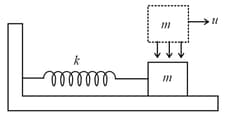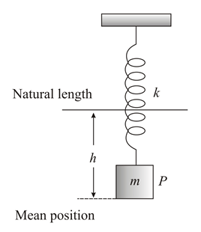Two blocks lie on each other and are connected to a spring as shown in the figure. What should be the mass of block placed on block of mass so that the system is period is . Assuming no slipping, what should be the minimum value of coefficient of static friction , for which block will not slip relative to block , if block is displaced from equilibrium position and released?
(Given: and )



Important Questions on Linear and Angular Simple Harmonic Motion
The potential energy of a body of unit mass moving in a one-dimensional conservative force field is given by . All units are in SI unit. Find the equilibrium position of the body.
The potential energy of a body of unit mass moving in a one-dimensional conservative force field is given by . and are in SI units. Show that oscillations of the body about this equilibrium position are in simple harmonic motion and find its time period.
The potential energy of a body of unit mass moving in a one-dimensional conservative force field is given by . All units are in SI. Find the amplitude of oscillations if the speed of the body at equilibrium position is .
In the figure shown, the block of mass collides with the identical block and after collision they stick together. Calculate the amplitude of resultant vibration.

Figure shows a block of mass resting on a horizontal smooth floor at a distance from a rigid wall. Block is pushed towards right by a distance and released. When block passes from its mean position another block of mass is placed on it which sticks to it due to friction. Find the value of so that the combined block just collides with the left wall.

Figure shows a block of mass resting on a smooth horizontal ground attached to one end of a spring of force constant in natural length. If another block of same mass and moving with a velocity towards right is placed on the block which stick to it due to friction, find the time it will take to reach its extreme position. Also find the amplitude of oscillations of the combined mass

Figure shows a spring block system hanging in equilibrium. If a velocity is imparted to the block in downward direction, find the amplitude of SHM of the block and the time after which it will reach a point at half of the amplitude of block.

